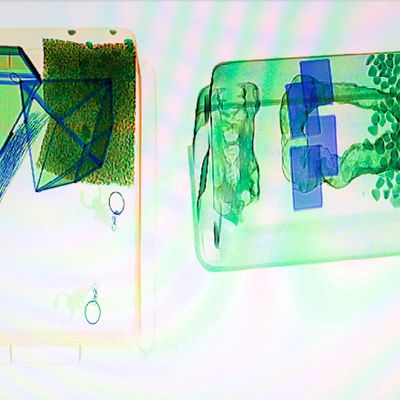
How do those airport scanners make you feel? Anxious. Stressed. Annoyed that you have to take out all your tiny bottles of shampoo. Mad at the person in front of you who seems to be completely clueless and confused about basic TSA techno-surveillance procedures youÔÇÖd think weÔÇÖd all be used to by now.
ÔÇ£I always get flagged,ÔÇØ artist Jillian Mayer admits. ÔÇ£I have a large sculpture practice so IÔÇÖm always bringing items of confusion from country to country, trying to explain why I have so many rubber gloves. Saying that IÔÇÖm an artist gives me an excuse for weird items that otherwise might seem like theyÔÇÖre one-third of an explosive.ÔÇØ
With her new series Still Life Scans (2018), a public commission for the Miami International Airport, Mayer got access to the scanners we all dread to make art. ÔÇ£I thought if I could approach them as aesthetic generators rather than just privacy invaders, I could usher a different emotional response.ÔÇØ
The Miami-based artist is no stranger to exploring our experiences living under surveillance. Makeup Tutorial ÔÇô How to Hide from Cameras (2013) gave YouTube users advice to subvert face recognition algorithms, and Impressions (2016), a series of billboards installed in New York, L.A., and Miami, made its focus biometrics and the way images of human bodies can be tracked and quantified. Still Life Scans is MayerÔÇÖs latest addition to a body of work that spans video, sculpture, and performance, interrogating our relationship to technology.
Birdseed, solar powered lights, handcuffs, and an LED belt buckle are some of the materials Mayer brought to the airport to create the photos. ÔÇ£I was given a few restrictions,ÔÇØ she notes. ÔÇ£No liquids and no weapons.ÔÇØ The airportÔÇÖs public-art program set her up using the baggage scanners at one of the airportÔÇÖs employee entrances ÔÇö using the scanners at a TSA security checkpoint was too complicated. ÔÇ£I had two hours to use the scanners before a shift change,ÔÇØ explains Mayer. ÔÇ£There was this one guy who worked the machine sending things backwards and forwards. And I brought a friend who helped me photograph the screen.ÔÇØ
Mayer quickly learned a few things. Metal was the most visible on the scanner. Fabric hardly shows up if at all. But the most interesting discovery? ÔÇ£The calm beauty of ring pops,ÔÇØ she says speaking of the candy crystal jewelry. It sounds like it was a bizarre shift for the guy working the scanner who Mayer kept asking what he thought of the images they were making. ÔÇ£I was like, ÔÇÿDonÔÇÖt you think this is beautiful?ÔÇÖ and heÔÇÖs just like, ÔÇÿWhaaat!?ÔÇÖÔÇØ
Working with the scanners on this project has changed how Mayer packs. Now sheÔÇÖs conscious of how sheÔÇÖs adapting her behavior to be more legible to an algorithm. ÔÇ£IÔÇÖm talking to the machine more when I pack. ItÔÇÖs like how Siri trains you to speak in a way she can understand. These are all different ways that we adapt to live more in symbiosis with the machines that rule our physical world.ÔÇØ
Mayer acknowledges that the infrastructure monitoring us is often too pervasive to avoid and too well-funded to change, but sheÔÇÖs interested in how we make creative adaptations to maneuver within it, hacking the systemÔÇÖs tools to create unintended joy and beauty. ÔÇ£I think itÔÇÖd be nice to pack a bag in a gradient from metals to organics to inorganics,ÔÇØ she says.



